View current page
...more recent posts
Paul Slocum emailed to say he appreciated the post on his work but perhaps isn't so happy to be slapped into the "circuit bending" category:
Is my work really circuit bending? key differences: (1) that traditional circuit bending has more of a chaotic element to it (placing wires without knowing exactly what's going to happen) where my stuff is mostly deliberate and calculated. And (2) while traditional circuit bending doesn't require much technical expertise, my work requires a ridiculous amount of geeky programming knowledge. (3) That my work really falls into the realm of software modification much more than hardware modification. All of my devices can easily be returned to their original state either by removing a cartridge or EPROM. Not so of circuit bend items. My stuff's like "Circuit Folding" or something.I described the genre as "emerging" but Ghazala says in the interview linked above that he started using found consumer electronics to make sound in the '60s. But the "instruments as sculpture" aspect of the trend perhaps isn't so interesting. The Nautical Almanac machines posted earlier intrigue because they look like form following function, whether that's actually true or not. (Genuine bricolage as opposed to self-consciously arty bricolage--though the guitar body is pushing it.) Similarly, just because one rewired a consumer device doesn't make the sound interesting. Again, I liked NA the times I heard them as much for the mic-swallowing, pushing-the-limit intensity of their live act--and complex, hybrid analog/digital sounds I didn't think I'd heard before--as the tweaking of instruments. The question here is whether circuit-bending is a big or well defined enough field to incorporate Slocum's light, software-based interventions into existing equipment and Cory Arcangel's hacked Nintendo cartridges. Maybe that is the evolution of the genre, rather than something completely different. Which is not to say I'm not guilty of indulging in a facile journalistic hook.
In your blog, you are usually pretty unforgiving of redundant art. Does circuit bending deserve a bit of a thrashing here? Reed Ghazala thoroughly explored the idea what, like 25 years ago? And wasn't Nam Jun Paik kind of a bender as well (long before that)? I love that bending is accessible to so many people, but in many cases the audio results are totally unlistenable. The process and concept is the interesting part, and that's been so explored. It seems like it's time for something beyond a confused Speak & Spell and croaking SK-1. I'm kinda torn about the whole thing.
New track: "Kill Maurice" [mp3 removed]. I made a video to go with this but I think I'll hold off on posting it. The molecular imagery seems too zany for this music. I learned a lot about editing, and sync-ing sound to images, but I'm starting to think I really hate video. It sucks your attention and demands more, more, more to a much greater extent than music, still imagery, or even looped .GIFs--it's an almost bottomless pit of (diminishing) content. There's a reason Billy Grant's rapidfire, overloaded videos are the way they are--it's what the medium has conditioned our eyes to expect. I've made three short vids now and dislike them not as videos, but philosophically, in that they seem to be trying to play the same game. Maybe I just haven't found the right fit between the music I'm writing and the imagery. But I also hate most MTV and it's hard to find a way around that model.
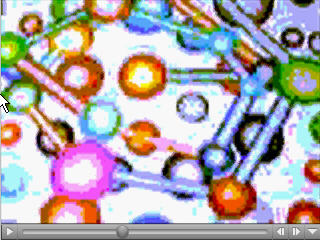
Above is a screen shot for an animated .GIF of mine that I saved as a 3.32 MB Quicktime movie. It depicts the growth of endorphins in a test subject watching Wheel of Fortune with his relatives at Thanksgiving (not really, I just put that in as a grant-friendly soundbite). Click here to view. One orange sphere is an "anomaly."
War and politics talk has been muted on this page since the shock of learning the exact number of torture-toleratin' Jesucrats out there (59 million, wasn't it?). Comments continue to trickle in along the lines of, "now let's not offend the Bushvoters." Of course I'd like those folks to admit their bloodthirsty instincts prevailed over what was best for America in the larger world, but my strongest bond is with people who marched against the war or had a sick feeling in the pit of their stomach when they saw the Abu Ghraib photos, as opposed to racist glee, numbness, or the naive belief that it was the work of "a few bad eggs." True, Kerry never mentioned the pictures in the campaign, but he at least had a conscience about US military excesses at one time in his life. Conventional wisdom had it that if he'd come off as a peacenik he would have lost even bigger. Now we're back to the Vietnam days of destroying villages to save them and glorifying Marlboro men for military exploits that mean...what, precisely? Oh, yeah, quelling local rebellions of Muslim extremists so that democracy can be spread to the rest of Iraq.
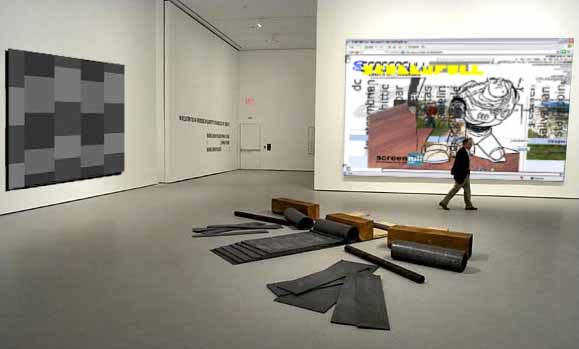
Haven't been to the rehung MOMA yet. On principal, this page worships Alfred Barr and believes his successors are "grocery clerks," to use Colonel Kurtz's phrase. Once it became apparent the museum would never be the dynamic collection Barr originally envisioned, shedding older works as it acquired newer ones, it should have left well enough alone and enshrined his gripping narrative as whole generations saw and remember it. Anyone not as smart and perceptive as he perhaps ought not presume to tamper with what worked--as in, sold the world on a particular (ostensibly too linear, politically unbalanced) vision of artistic change at a particular moment in history. Whatever one thinks of Cezanne's position as the cornerstone of pictorial Modernism, the current staffers' substitution of that corny Paul Signac in his place at the entrance is just lame. Dress the decision up as they will, as signifying the importance of proto-Pop or what have you, it was evidently a flattering-the-donors move, as the Signac is pledged to the museum by David Rockefeller. Above, left to right: Christopher Ashley, Robert Morris Serra, Abe Linkoln. Picture courtesy Screenfull & Look, See.
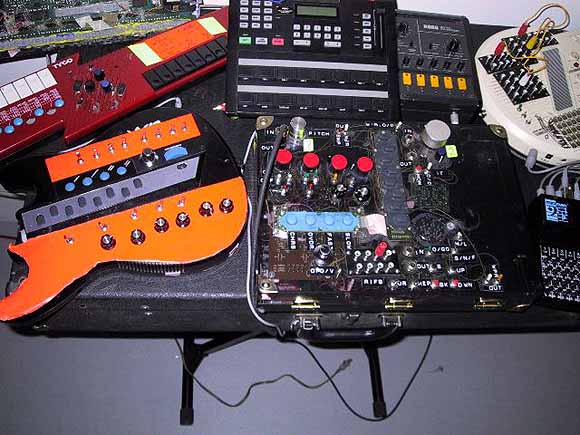
As an example of the circuit bent gear phenomenon mentioned in the previous post--this is Nautical Almanac's equipment table.
Paul Slocum is doing some interesting work in the emerging "circuit bent" field, where old games, toys, and keyboards get broken open and rewired to make new sounds. Check out his repurposed Epson dot matrix printer that makes music and still prints out images. This is fascinating on the level of Mad Maxian, Professor-making-a-nuclear-reactor-out-of-the-ship's-radio-and-coconuts bricolage (or as an illustration of the Gibsonian axiom "the street finds its own uses for things"), but the printer is only part of a larger gesamtkunstwerk, including Slocum's band Tree Wave (a duo with Lauren Gray), which is making some of the coolest music around. While the band uses the printer and other low-tech gear (1977 Atari 2600 game console, 1986 portable 286 PC, 1983 Commodore 64 computer) to make its music, it's not the annoying, tuneless gameboy stuff we've been hearing in the galleries lately but rather has been compared to guitar bands such as My Bloody Valentine and early Stereolab. This is because the computers use fuzz tones and other psychedelic guitar-like sounds as opposed to pure video game bleeps. "Sleep" is a simply amazing 3 minutes of music that updates the Krautrock formula of drones-over-insistent-beats with rich, jangly, unmistakably consumer-electronic textures that just seem to keep surfacing in the mix. Catchy, crunchy rhythms kick away underneath while spare but sublime femme vocals float in over the top. The equipment runs with custom music software written by Slocum for the band, obviously with a very analog-sounding end product in mind. According to the website there is also a video element used in live performance. Hopefully we'll get to see and hear all this here in NY soon.
UPDATE: Slocum's thoughts on whether his work is really circuit bending here.
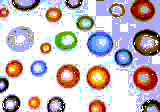
The Creepy Clown website has been mentioned here a few times (originally in this post) as an example of a populist, database-oriented art project that actually has some life to it. In all honesty, much of it is crap. For those who don't know, Creepy is a downloadable stock character made in a 3-D rendering program such as Bryce or Poser and plugged into a variety of situations and settings. The site formerly had a front page displaying some of the best Creepys, but now it's all grouped by artist and you have to slog through many inane pictures of Creepy making bunny ears behind George Bush's head to find what I consider the "classic Creepys." Fortunately I saved many of them from the original front page and offer them here as a public service. The ingredients of a classic Creepy are: (i) technically amazing rendering skills bumping up against the inherent "uncanny valley" artificiality of the program, (ii) a cheesy Americana or suburban setting, (iii) Creepy as a silent stalker, just standing there in a place he's not supposed to be. The best ones are chilling as well as dorky. The Creepy sitemeisters might not agree with these criteria; they seem to give equal weight to images (still!) of Creepy dismembering The Dancing Baby.
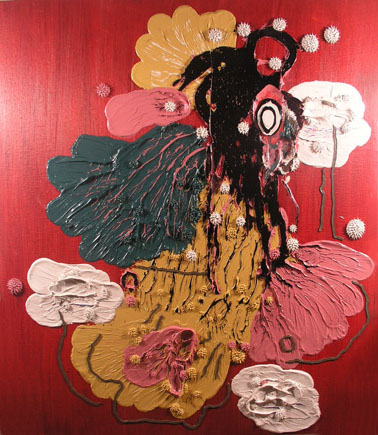
One recurring theme in the Rhizome.org blog panel tonight that is contradicted by Dennis Hollingsworth's blog: the idea that the art world always seeks to mystify and restrict access to the creator's output. Hollingsworth shows with Nicole Klagsbrun in New York and his work gets out there, as in, it's collected. He's a terrific painter and I thoroughly enjoyed the last show I saw at Klagsbrun. Complex stuff in the poMo ab-ex tradition, more seductive and paint-loving than, say, Jonathan Lasker (who I also like). Yet here Hollingsworth is on the web, letting you in on his studio process, both the physical making of paintings and his thinking about them. The above image is my slight cropping of a studio snapshot. More images are found in his post. He's a natural, talkative blogger and his step-by-steps are a gift to fans. Some artists protect their processes like trade secrets--Hollingsworth's openness shows his confidence that only he can make these paintings, and that online discussion only adds to their value, in the pure as well as commodity sense.
At the Rhizome.org panel tonight I recommended someone who I thought was a female blogger for a future panel--turns out that Amanda Congdon, while female, is actually part of a team. Rocketboom is a collaborative video blog produced by her, Andrew Baron, and Josh Kinberg. Congdon is an actress/comedian and the "face" of the project--not really "the" blogger, unless Rhizome were to invite all three of them. Still, the page is worth checking out--some very funny videos there in a fake news report format. Vote for Chris Christmas Rodriguez to Replace Santa Claus This Year and the news story on Topeka high school students abusing PHP are great. (hat tip to drat fink)
The panel was fun tonight, nice to meet everyone. Thanks to Francis Hwang for organizing it. And it was startling to see how many art world people turned out to hear about this hot phenomenon called blogging. Not. A few did, though--the cool ones.
The research paper on art blogs by Danish student Marie Omann, mentioned in an earlier post, has been published in PDF form on the MTAA blog. It's certainly relevant to the Rhizome.org panel on arts blogging tonight. I was flattered to see how much of her research came from posts and comments here, as well as to see all the input from the MTAA blog and Sally McKay's blog. Also on the MTAA site are questions posed to tonight's panelists by Rhizome Director of Technology Francis Hwang, and T.Whid's replies. I feel like I've been answering them all week so I'll save more specific replies for "meat space," as we unromantically call it. But here's just a quick recap of the last few posts on tonight's four panelists: who they are, what they do, and an attempt to make some connections through annoyingly brief summaries. (Oh, and before I forget, painter Dennis Hollingsworth also has posted answers to Marie Omann's questions on his blog. Dennis, no one said tonight's panel was going to be about "How can we use blogging in the artworld?")
David F. Gallagher
1. Photoblog of his own photos, and links to his big-media articles about blogging and other topics.
2. Subject of photoblog is New York City streets, but also travels elsewhere. Going to Italy with him vicariously was very enjoyable.
3. Interesting relationship between the photos as stand-alone art and the photos as components in a ongoing narrative. Occasionally the lines of his activities cross, as in his Slate article on the photoblogging phenomenon.
T.Whid
1. Photoblog documents activities of artist team MTAA (T. Whid + M.River), plus rants on politics and other subjects.
2. I'm shamefully undereducated on MTAA's total production, which is net art or new media work combining video and programming within a conceptual art framework--so I bluffed my way through a discussion of one recent piece and we had some back and forth about it on our weblogs.
3. According to M.River, the MTAA blog "has been designated to be 'not an artwork' but may contain some things that are artworks."
Kabir Carter
1. Sound blog that eschews recorded sound in favor of terse, poetic descriptions of sounds.
2. Subject is urban environment--New York City streets but occasionally other locations (e.g., someplace with beach sand and manatees). Incorporates "moblogging"--contemporaneous recording and posting to the Net of real world events through cell phones/handheld devices.
3. Blogging appears to be broken into discrete projects--bloglets? They are art, as opposed to documentation or work-in-process for something else. Net art using the blog medium, for want of a better description.
Tom Moody
1. Blog is documentation of ongoing studio production. Art objects (mostly abstraction, but occasionally portraits and dumb cartoons) made with the computer, but also music, animated .GIFs, and initial tentative stabs at video.
2. Blog veers wildly into narratives and rants on other subjects--politics, movies, electronic music, science fiction, etc. Oh, yeah, and art criticism.
3. The blog is not art but art often appears on the blog. Which explains the appearance of more medium-specific (browser-oriented) work such as animated GIFs since the blog began in 2001.
Great post by Steve Gilliard on why the "big" blogs (Atrios, Sullivan, etc.) are becoming more popular than established opinion journals, and more successful than sites from the dot-com era. It is relevant to our upcoming panel discussion on blogging and the arts not for its discussion of the profitability of blogs--though there's more to say on that--but rather what makes them "work" as a vehicle for content delivery where the dot-com sites failed and where print journalism seems lagging. Much that he says feels right in the art context, although no clear leader is emerging the way the bloggers he mentions dominate political discussion. That's probably just as well--art would be better served by a network of micro-specialized blogs and a few aggregator sites, as opposed to some uber-critic who had the power to influence careers and sales. It was very disturbing to move to NY almost 10 years ago and discover that NY Times critic Roberta Smith had the ability to sell out shows, and that she and Jerry Saltz were perceived to be the only game in town in terms of an artist's or gallery's financial success. The last thing we should want is a blogger with that kind of influence. As for selling ads, it seems to be working for political blogs to give the writers the autonomy to say whatever the fuck they want, but the same would not be the case with art-related blogs. Galleries don't have much to spend and expect some return on their investment. It's not just about "eyeballs."

I've been checking out a recent Rhizome proposal and related blogs by sound artist Kabir Carter, the fourth panelist in the upcoming blogging and the arts event. Carter's sound blogs (a term I'm using, not entirely accurate--more below) are linked to and described there as follows:
I say the term "sound blogs" isn't entirely accurate, because unlike, say, David F. Gallagher's photoblog, which also records urban details in a diaristic way, Carter's journals don't document sounds via regular posting of .mp3 files, but rather verbal descriptions of audial phenomena. Many of these short, pointed, often poetic statements enter the journals "moblog" style--as the artist notes above, he types them into a handheld device, on the spot, from the locations where they were heard. The entries resemble a foley artist's deadpan record of sound effects in a movie or TV storyboard. Many of the "sounds" are actually visual descriptions of sound-producing activities, followed by the word "(inaudible)."Effects
Effects is my first net project. Originally posted as a "stealth" LiveJournal blog, Effects purports to be a diaristic account of my life, but instead only offers dry accounts of sounds that I have heard, or imagine to have heard. While attempting to make LiveJournal friends who can track my accounts, I have periodically contributed to an ever growing catalog of acoustical accounts that never reveal much about me, but hopefully say many things about how I have experienced sound.
http://www.livejournal.com/~effects/Walking In The City
I am presently realizing Walking in the City, a project commissioned by Subtropics, a Miami based music festival. I moblog (in real time) written descriptions and accounts of acoustic occurences that I audit while walking around New York City. The project was launched during Subtropics' festival opening, where 4 hours of my updates from the city were projected live in an arts and performance space in Miami. Until early April, I will continue to intermittently add to the initial log.
SFX: Two Street Signs Affixed to Same Post Vibrating against One AnotherI'm reminded of the Kenneth Goldsmith piece where the artist transcribed every word he spoke for a week and hung the transcriptions in a gallery. Like Goldsmith's work we take it on faith the artist isn't making stuff up. But Carter's blogs aren't as obviously sequential: he's moving around the city, and readers often must rely on their own deductive faculties to tell how (or whether) the sounds relate to each other--especially in the subtropics blog, where there's no timestamp. A run of posts gives you a feeling of momentary total immersion in a cacophonous, slightly unhinged street scene, and then you're abruptly transported underground, into a subway environment that feels equally random but has its own characteristic sonic events. The sheer amount and complexity of detail paints a cumulative impression of the city not ultimately that dissimilar from Gallagher's far more "accurate" (as in verifiable) photographic record. Both conjure a teeming world beyond our normal mundane powers of observation.
SFX #234 SFX: Bell Struck
SFX #233 SFX: Two Small Dogs Barking in Unison
SFX #232 UNKNOWN PERSON: "Not my fault the watermelon tastes like..."
SFX #231 UNKNOWN PERSON: "Police officer, can you go to the end of the train? There's a guy with a bag and blue jeans."
SFX #230 SFX: Droplet Falling from Small Bent Conduit (Inaudible)
Reading Carter's blogs is highly recommended, although they would doubtless have a different kind of interest if you were one of those baffled LiveJournal Friends experiencing them in blog time--that is, following the posts as they appeared.
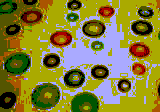
Artist and blogger T. Whid, a fellow panelist in the upcoming Rhizome blogging and the arts event, is part of the art duo MTAA, along with M. River (their blog is here.) A Globe and Mail article on MTAA's current online artwork 1 Year Performance Video is here and I reposted it here. 1 Year Performance Video revisits a classic conceptual-era work by Tehching (Sam) Hsieh, where the artist locked himself in a cage-like cell for a year, and arranged for friends to bring him food and take away his body waste for the duration. (Shades of Wladyslaw Szpilman in The Pianist, minus the plumbing.) Recreating the work online, MTAA has made fake cellcams showing the two artists sitting in separate sealed rooms--fake because the pair aren't actually in cells, only posting video loops that show them doing things they might be expected to do at appropriate times of the day. As the artists explain it, they use computer technology to take the suffering out of Hsieh's performance and put the onus of the one-year commitment on the websurfer, who uses a cookie to literally log time watching them.
Pieces that refer so specifically to known, past artworks, satirically or otherwise, are problematic--more on this below--but there's much to think about here. Unlike the Globe and Mail, I'd discuss the work in terms of voyeurism, and artist recuperation of the part-guileless, part-sleazy home webcam phenomenon. In real (Internet) life, the only reason a surfer would stay with a site like this for hours was in the hope that the subjects might do something kinky. I know there are people watching this for art, but why? Perhaps the presence of white plastic buckets in the rooms creates some morbid curiosity about how the artists handle basic elimination needs, but frankly I didn't stick around to find out.
Like Penn and Teller explaining a magic trick, the artists reveal--on a related web page--quite a bit about the scripting and webserving mechanics behind their simulation. This geeks-only backstory actually makes for fairly fascinating reading. One guesses the commercial voyeur sites do something similar--calling up particular loops at particular times of the day to fool the rubes. There is also the cliche of a hundred spy thrillers where fake footage of a surveillance subject is inserted into the bank of video recorders to confound the watchers. For sure the technology changes Hsieh's piece quite a bit, which did allow observers, but only at specified times, like a prison visit. Ultimately the MTAA work's relationship to current tech-shaped behavior patterns and pop culture tropes feels more compelling than its parody of the Hsieh performance, which is almost by definition an art world in-joke, with a singular interpretation: that when computer-age art revisits the physically demanding, emotionally wrenching work of yesteryear, an insincere, fast-food facsimile inevitably results. Sorry to leach the humor out of it, but there it is.
Addendum: And speaking of webcams, dave found this article about "net or remote hunting" of animals, an example of life trumping art for sheer fuX0red weirdness. (Assuming it's not a hoax.)
David F. Gallagher, one of the panelists in the upcoming Rhizome blogging event, wears two hats: committed photoblogger of his own punchy, artfully composed images (I linked to him a few weeks back when discussing the artists "trashing" Terminal 5) and media journalist covering the controversies and mutations of the emergent blogosphere. If you knew about the schism between crazy right wing "warbloggers" and the rest of us, which became apparent when they got a book deal and we didn't, it's possible you first learned about it in an article of his in the New York Times. Ditto the failed attempt by Warner Bros. to co-opt .mp3 bloggers. As I mentioned earlier, the first appearance of the term "web log" in the Grey Lady was in an article of Gallagher's, on December 28, 2000.
Occasionally his interests converge, as in this Slate piece on photoblogging. He invokes the image of cigar store owner Harvey Keitel taking daily random photos of the same section of city street in the movie Smoke as a metaphor for the demotic, "anyone can do it" aspect of photoblogging. That definitely comes across, but I've often thought about what a novelistic contrivance Keitel's picturetaking was. Within the film's own logic, he has this slightly kooky personal hobby that just happens to resemble a rigorous conceptual art project. The purpose of the conceit--besides the obvious plot point of Keitel "accidentally" photographing William Hurt's late wife, and thus ending Hurt's period of grieving--was, I think, to present Brooklyn as a place so steeped in renegade art style that even the man on the street had internalized it.
Photoblogging, on the other hand, isn't local, or particularly bohemian--it's a worldwide, bottom-up phenomenon, where practitioners are as arty or as artless as they want, or have, to be. The conceptual element comes in deciding on the parameters of the blog (on the practitioner side) and what value the practice has, on the consumer or curatorial side. Is the photoblog factual documentation or personal vision? At what point does a John Cagean interest in the aesthetics of random urban phenomena ("I am standing on this street corner shooting these buildings") intersect with the need for accurate images experienced by, say, a historian or a police investigator?
Photoblogging is photographing but it's also "databasing," and changing the subject slightly, I note that ex-Walker Art Center new media curator Steve Dietz has an exhibit coming up on that subject, which looks to be the typical analytical, anecdote-driven new media event. My general beef with such shows is that they privilege the rational over the intuitive. Instead of flouting viewer expectations, looking for disobedient, ecstatic, Dionysian uses of the computer, curators love to emphasize the data-crunching everyone already knows it does well. Whereas the more interesting story is how it's misused as an art-making tool, in hiphop, "dirtstyle" web design, etc. Fortunately, at a certain point homegrown, tribal, "amateur" efforts begin to overwhelm more earnest, grant-conscious, faux-sociological production. "Life finds a way," Sam Neill marvels in Jurassic Park, on discovering mating dinosaurs in a supposedly sterile environment. And so does art.
|
||||||||||||||||
|
||||||||||||||||
|
Untitled (Clear Evening After Rain), 2004, HTML, 365 x 550 pixels, from Look, See, Chris Ashley's weblog. A CD-ROM was recently published of the HTML drawings that appear daily on the blog. I continue to be intrigued and impressed with Ashley's use of the weblog as a medium for abstract art made in the same language as the medium. It's transparency in every good sense of the word.
Rhizome.org to host Blogging and the Arts panel
Public Program:
Blogging and the Arts
Tuesday, November 23, 6:30 p.m.-8:00 p.m.
Location:
New Museum of Contemporary Art / Chelsea
556 West 22nd Street
*** Rhizome.org Director of Technology Francis Hwang will lead a panel discussion entitled Blogging and the Arts. The panel includes artist Kabir Carter, photoblogger and journalist David F. Gallagher, artist and critic Tom Moody, and artist T.Whid. The discussion will address questions such as whether blogs will change the nature of discourse in the fine arts field, and ways that artists and critics are integrating this new form of communications into their own work. ***
About Rhizome.org
Founded in 1996, Rhizome.org is an internet-based platform for the global new media arts community. Through programs such as publications, online discussion, art commissions, and archiving, it supports the creation, presentation, discussion, and preservation of contemporary art using new technologies. Since 2003, Rhizome.org has been affiliated with the New Museum of Contemporary Art.
This is an interesting mix (including me blah blah), and overdue. I think the new media community will learn of this event via the cyber-Drum and hopefully some will turn out. If anyone knows gallerists or critics or other real space artworld types, please tell them about this because I'm still getting blank looks from that quarter on the subject and/or value of blogging. The art journalism lag on this is frankly pathetic. Artnet (a magazine, not a blog digest) still practically owns the cyber-art-journalism field, although individual blogs such as Tyler Green's are getting more widely known. But the phenomenon of independent blogs embarrassing Institutional Media and demanding that it be more accountable hasn't happened in the art world as it did in politics. Also, "name" critics aren't starting blogs as they have in the political/mediacrit sphere. Vanity Fair scribe James Wolcott has a blog now, so where is Jerry Saltz's? Roberta Smith's? Robert Storr's? David Rimanelli's? Why are they still hiding behind the cloak of institutional authority? Do they need editors that much? Are they insecure?
These are my pet peeves, though: the Rhizome panel, by its choices of who was invited, is less grouchy (or, of more universal interest) in that it focuses on practicing artists and how blogs are impacting their work, rather than the deficiencies and pathologies of institutions. I hope to write more about the other panelists (based on surfing their blogs) in advance of the event. [One interesting factoid: Gallagher in his journalist career is the first writer to use the term "web log" in the New York Times, on December 28, 2000.] On his blog, twhid asks for suggestions about what to talk about. I'm similarly open here, but refer readers to an earlier dialogue I had with twhid and others in response to a Danish student's questions about "artblogs," which she seemed to assume were a much more evolved and accepted entity than they are. Here are some relevant links:
What is an art blog? 1 / 2 / 3 (scroll down)
One afterthought: the panel lists me as "artist and critic" but I prefer "artist who writes" (or better, just "artist") because the art world is quite old-fashioned and actually punitive in its expectation that artists will only wear one hat, and will otherwise be perceived as uncommitted. Starting this blog was a way to scrape off some of the barnacles of institutional criticism that I found attaching to myself; I guess it's not working, but then I can't make myself shut up.
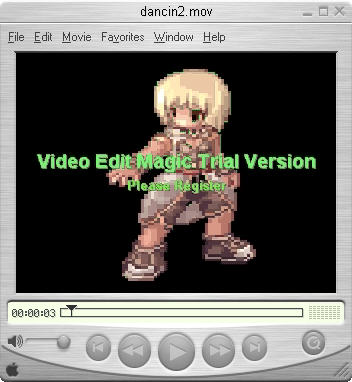
Notes on my video, Dancin' (Please Register).
1.The soundtrack is a short version of "Streetsong 2" [3.48 MB .mp3], originally posted here.
2. The video is comprised of these animated .gifs swiped off the internet ("like stealing a candy bar from a drugstore"), plus a few more found at the link below. All are resized at 240 (tall) by 320 (wide) pixels. They run sequentially, with only one on the screen at a time. Each appears more than once (some many times), for a duration no less than four piano notes per appearance (and no more than 8). The order varies; the .gifs are mixed and matched and arranged with an eye to rhythm and the element of surprise. Speeds of individual .gifs also vary.



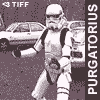




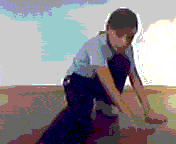
more animated gifs
3. After 1.25 minutes of this foolishness, video fades to black at end. "Trial version: please register" overlay will probably remain throughout the piece (I haven't decided yet).
The video is priced at $500,000. Proceeds after deduction of expenses for a private party in Terminal 5 will be placed in trust to be clawed over by attorneys for individual .GIF-makers.
Update: The completed video is here.
Thanks to all who posted encouraging comments about my first foray into video. The piece is coming along, it's now down to 50 MB and I jury-rigged a way to sync the audio. I was able to save a thumbnailized, super compressed copy at 9.5 MB, but it looks like, um, shit.
Many of the comments were about trying to get me to switch from a PC to the Macintosh ecosystem. I have more to say on this subject, but in brief, I don't know how I can continue to claim, in my artist statement, that "My work proudly inhabits the 'lo-fi' or 'abject' end of the digital spectrum" if I am using the ideal, "hi fi" system. I wound up in PC-land quite by accident, but it's the way I think most people end up there: it's the computer of choice of managerial types in the American workplace. At a certain point I had so much PC-made work on floppies (done on lunch breaks, of course!) that when my old Mac SE no longer cut it at home, I had no real choice about what to buy to replace it. But this is boring. I also perversely like being outside the orbit of the Mac fetishists, where things tend to look and get done a certain way. I've kidded elsewhere about the laptop chic of New York art events--part of me wants to join it, but there's also something to be said for using the tools of the proles. Think Carl Andre in his carpenter overalls. Oops, not a good example.
How It Works...The Computer. Good clear scans of individual pages show differences between the 1971 and 1979 editions of this (high school?) reference book. Highly informative, high kitsch appeal, what more could you ask for? (via cory a. & eyebeam reBlog)
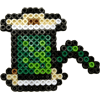
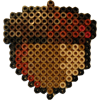

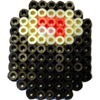
Reviving the ancient practice of barter that lay behind the putative origins of our fair city--that is, the ability to trade almost anything for a handful of beads--is Mondo Mondo Trading Post. Go to the 6th Floor at Cooper Union during the hours listed below and swap anything you have--a poem, a song, a piece of crumpled paper lying at your feet--for a pretty souvenir made of Perler Beads, a craft kit item I'm told I'd know more about if I'd recently left high school. The Mondo Mondo traders, Kevin McGarry and Matt Savitsky, have taken their economic roadshow up and down the Northeast, setting up temporary displays with cardboard totem poles, an array of multi-hued blankets, and a table of Souvenirs. Trades are documented with online photos of the crap (and also good stuff) people coughed up. From the website the project looks to be a combination of hippie-era hopefulness about creating an alternative system of exchange and a kind of wised-up parody of a colorful kid's show world where the bottom line is you take home something made of plastic. Judging from the pictures of McGarry and Savitsky stoically manning their booth in a host of public spaces (plazas, museum grounds, bookstore sidewalks), there is something beautiful and sweet about the activity but the stupid factor is not to be overlooked--the quality of the hapless, doomed quest to change the world through a single throwback gesture. The website captures the spirit nicely, with its melange of happy colors, texture-mapped wood grain, and sprightly MIDI tunes downloaded off of various fan sites (especially fine is the one that greets you on load-up, Radiohead's "Paranoid Android"). Hopefully I'll have a chance to go tomorrow and can give a better report.
Saturday Nov. 13th - 3PM to 5PMUPDATE, Saturday, Nov. 13: Visited the Trading Post and found it as winsome as described. One slight inaccuracy above is the trades don't stop with you taking home a Souvenir--everything ever traded is for sale. Previous swaps from New Hampshire, PA, NYC, etc. were arrayed around the room in hand-cut cardboard display cases. Poems or stories were handwritten on card stock and would be recited or reenacted by the proprietors on request. I traded a Gimme Shell 7-inch EP for a robin's-eggs-in-nest Souvenir. It's a gem.
Wednesday Nov. 17th - 9PM to 11PM
Saturday Nov. 20th - 6PM to 8PM
Blog Spotlight: Loretta Lux
"They are imaginary portraits dealing with the idea of Childhood. Childhood has been idealized as a lost garden paradise to which we can never return. We are excluded from this world of carelessness, innocence and unity. But the imaginary kingdom is nothing more than a projection of adult ideas and concerns onto the image, an expression of our own yearnings." - Loretta Lux.
According to her press page, Lux's "images are created using photography, painting and digital tinkering. She photographs the child then places the resulting image on a backdrop that she has painted or photographed separately. On most of Lux's images the colours, and sometimes the children's features, are digitally altered."











This is startlingly good work, a little scary because we're not used to seeing our cultural fetishization of children carried to quite this degree of care and craft. Also noteworthy is the hybrid nature of these images. Would they have been possible were Lux not equally skilled as a painter, photographer and digital artist? I don't think so. A prediction: this will emerge as more important work than John Currin's similarly polished but differently odd paintings, in that Lux has mastered a new technology in order to invent a medium to go along with her imagery, whereas Currin is just the latest in an unbroken cycle of "getting back in touch with the lost master painting techniques of yesteryear, blah blah."
UPDATE: Speaking of cycles, a friend asked why I'm just writing about this work now when tout le art world already chewed it up and spat it out (favorably) last spring. I replied that this blog isn't a slave to the usual rhythms of capitalist marketing hype--that it's impulsive, heedless of fashion, and also, I wasn't paying attention.
I made my first video last night. Woo. Kind of a first stab at integrating the music I've been writing with the animated .GIFs I've been drawing. First, I downloaded a demo version of a simple video editing software. I imported an .mp3 of a tune I wrote and then started adding some found .GIFs from my "collection," since that's the first folder that opened (*%&%! Windows XP always defaults to that lame "My Pictures"). The video editor is nice in that it automatically resizes all the .GIFs to the size of the first and can make them faster and slower, but not so nice because there is no way to sync a specific sequence of musical notes in the audio to the run time of the .GIFs. I put together my file as best I could--a parade of stupid cartoon characters dancing, completely out of step with the music--and then saved it as a Quicktime .mov file, just to see what kind of file size we're talking about. It took about 10-15 minutes to save and the 2.5 minute long video is (ouch) 77 MB. I just used the preset compression options, though. Also, the finished masterpiece has the words "Trial Version--Please Register" pasted in the middle of the screen the entire run time, in green letters. I like that, though--gives it a certain shabby authenticity. Any recommendations of a Windows-based video editor that allows syncing of audio and images and that can save output as multiple file types (particularly .mov) would be greatly appreciated.
Xxx xxxx OOOOOOOO X xxxx xx xxxxxx xxx xxx xx O-OOOOO xx x xxxx. Xxxx xx xxx, xx xxxxx x xxxx xx OOO OOOOOOOO OOOO. Xxxx X xxxx xx xxx xxxxxx xxxx xxx 0O0 O xxx xx OO0O. Xxxx X xxx OOOOOOOOO 00000000 xxxxxx xx xxx xxxxx, xx xxx x xxxxxxxxx OOOOOO OOOOOOOOO! X xxx x xxx xxx xx xxxx 000 OOOO xxx 000 0000000 xxx xx xxx xxxxxxxxxx 0O0 xx 000. Xx xxxxx xxx xxxx xxx 0000000 OOOOOO xxxx xx xxxx xxxxxxx OOOO xxx xxxxxx.. xxxxx xx xxxx. Xxxx xxx xxx 00000 OO OOO 0000. Xxxx xx xxxx xx OO OOOO xxxx xxxxx xxx xxxxxx x 00OOO 000 xxxx. Xxxxx xxxx 000 OO xxxxxx xx xxxx xxxxx. Xxx xxxxxx xxxx xxxx xxxxxx xxxxx xxxx 0000 OOO. Xxx xx xx OOOOOO 0000, xxx xxx xx OOOOOO 000 OOO. Xxxx x xxxx xxxx xxx xxxxxx xxxx xxx xxxxxxxxx 000000. OOO 000000000 OOOOOOO xxx xxxx xx xxxxx. X xxxxxx xxxxxx xxx xxxx xxxx xxx xx OOOOO 000 xxxxx xx x 000000 OOOOO xxxx xxxxxx xxx xxxx OOOOOOO 000000 xx x 000000 OOOOOOOO xx xxxxxx xxxx 000 OOO 00000. Xx xxx x OOOOO 000000. OOO 0000000000000 OOOOO 0000000000 xxxxxx xxxxx OOOOOOOOO 000 xxxx xxxx xxxxx xxxxx xxxx. Xxx xxxx xxxxx xx 00000OOOO, 00 OOOOO. X xxx xx x OOOOOOOOOOO xx 000 00000000 xx xx xxxx. X xxxx xx xxx xxx xxx x OOOOOO xxx 0000000 xxxxx xxxx xxx xxxx xxxx OOO 00000 xxx xx xxx x 00000 OOOO.. xx xxx xx OOOOO .. x xxxxx xxx 0000 OOOOOOO. Xxx xxxx xxxxxxxx x xxx x OOOO OOOOOO. Xxx xxxx x xxxx xxxxxxx xxx xxxxxxx x 0000. Xx xxx xxx 0000OOOOO xxx x xxxxx x 0000000000. Xxxx xxx xx xxxxxxxx xx x OOOOOOOOO. Xx xxx OOOO xx xx xxxxx. Xx xxxxx xxxx xx xxx 000000 OOOO xxx xxxxxxx xx OOOO 000000 OOO 0000000000 xxx xxxx xxxx OOOOOOO 00 xx xxxx xxx xxxxx 0O0O oo00O O00 xxx xxxx oOoOoOo 000 OOOO. Xx xxxx OOOOOO 00 OOOOO oooo xx x OOO OOO 00000 xxxxxx oOoO0 OOOO OOOO, xxxxxxxx x 000000 OOOO 00000OOOOO. X xxx x OOOOOOO 0 xxx xx xxxxx xxx xxxx xx 000000. Xx xxxx OOOOOO 0000 OOOOOOOOO xx x xxxx OoO xxxxx. Xxxxxxx xxxx xxx xxx xxx OOO 00000 OOOOOOOO.. xx xxxxx xxxx xxxx xxx xxxxx OOOO 00000. Xxx x xxxx x xxx OOOOOO 0000 OOOOOO xxxxxxx xxx xxxxx xx x 0000 OOOOOO xx xx xxxxxxxxxxx.. xxx xx xxx xx xx xx O ooooooo OOO 0 00000.. xxxxxx xxxx. X xxx xxxx xxx xxxxxx OOOOO 000000 xxx xx xxxx xx xxxxxx'x xxxx, 0O0 oO O. Xx xxxxx O OOOOOO 0000000 xx xxx xxxxxxxxxx xxxxxxx xx xxxx xxx xxxxxxxx xxx xxxx.. xxx xxx~!
The New York Times' "news window" or "news hole" is obviously shrinking (this usually happens as a result of falling ad revenue) and its art review section has recently been fairly drastically reduced. In days of yore that would have been cause for hand-wringing about the demise of importance of visual art in our culture, but now I say, good! 'Cause, see, there're these things called blogs, which can run critical commentary and pictures about shows and even have bulletin board type discussion of the work while it's up. What a concept! The shrinking copy hole may mean dealers have to look elsewhere for legitimation of the work they show, and--oh my God, all this time, while they were waiting for Roberta to come by and give the show an authoritative nod there's been a vehicle out there that could have been used to disseminate information and discuss ideas! And its power is based not on the top-down institutional authority of an entrenched critic but rather rhizomatic, community-based weighing of opinion and more or less instantaneous transmission of buzz! Who knew?
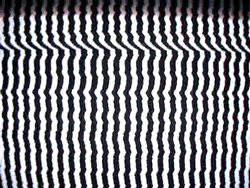
.GIF by jimpunk (from SCREENFULL: "we crash your browser with content").
"Eye Music." This post will eventually get around to techno music, but let's start with Claude Debussy. It's almost a cliche of criticism to compare the French composer's shimmery tone clusters to Impressionist painting. Daniel Albright's book of comparative aesthetics, Untwisting the Serpent: Modernism in Music, Literature and the Other Arts, takes a 180 degree tack, disagreeing with an assertion by Ezra Pound back in the day that Debussy's music is "suggestive of colors, suggestive of visions." According to Albright,
[...] Debussy's music is typically an art of slight temporal adjustments, discursive, an artful series of instabilities; it seems visual only because of the peculiar evolution of the visual arts in Europe, from the notion that the primary act of drawing is the recognizable depiction of a finite object--as it is in most cultures--to the notion that the primary act of drawing is the recognizable depiction of the eyeball's whole visual field. In Western art, the space in which objects appear is often more vivid than the objects themselves: perspective drawing carefully poses and graduates the objects that it treats, to create the illusion that the artist is presenting everything that a certain angle of vision makes available. Debussy's works are like French impressionist painting--or like Renaissance chiaroscuro, for that matter--in that the mind tries to grasp fleeting visual phenomena from a puzzling density of events. But it is not Debussy who is visual, but Monet and Leonardo who are discursive, in that they require the spectator to apprehend slowly and work out over time the possibilities inherent in the painted surface.The above paragraph is bang-on, but now it starts to get confusing:
Truly visual music, it seems to me, is epigrammatic: music that operates by means of instantaneously grasped units, pieced together not according to progressive tonalities, not according to some standard template of evolution (the sonata-allegro, the fugue, the rondo, the three-part song), but according to any principle that can not be understood as discursive development. Music becomes visual simply by lacking musically comprehensible connections between its parts, and by having parts that permit rapid apprehension as elementary units. Certain older procedures of form, such as the rondo (a repetitive piece with a pattern of symmetrical digressions, according to a scheme such a ABACABA), can approach the condition of eye music, in that the listener is conscious of the phonic equivalent of charms tallied on a bracelet; and as A and B get shorter and shorter, and as the musical links between A and B grow more unsettled and hard to understand, the composition will increasingly lose any sense of temporal progression and flatten into eye music. [...]These paragraphs sum up an earlier discussion of the "hieroglyph" or the "epigram" in music, a self-contained sonic event usually but not necessarily paired with words or some onstage deed. Albright describes these melodies or moments as having visual-like properties within the larger continuum of the piece. He gives several examples: the "oracle tune" in The Magic Flute, musical cues for specific emotions in silent film, and the motifs of the medieval master songs in Wagner's Die Meistersinger. Regarding the latter, he writes: "The rules [of the master songs] are discursive, but the discourse is chopped into tough leathery chunks, so predictable that the ear stops straining to understand, simply waits for the next bit to fall in place. A musical composition that consists of stringing-together of cadences has no possibility of moving toward a goal, no possibility of genuine discursive development at all." So in the rondo example above, the development of self-contained, multi-note motifs over time remains musical until the ear can no longer sort out their "narrative" structure, at which point they become visual--mere blocks of notes being absorbed and compared. Later, in describing the collage of musical motifs in Stravinsky's Renard, he concludes:
[T]he Modernist taste for ocularity in music, for easily-apprehended pattern-units juxtaposed rather than developed, brought the principle of scissors construction [collage] to its highest level. It is remarkable how strongly this procedure in sound appeals to the visual imagination: when I hear Stravinsky, I often feel exactly as Pound felt hearing Stravinsky's Capriccio in 1935--that a kind of slide projection of the score starts to hover in front of the music: "I had the mirage of seeing the unknown score from the aural stimulae offered."I still have questions, though. How can you envision a score without hearing a relationship between its parts? How is it that charms on a bracelet are "apprehended" musically but not as an image? Earlier in the book, Albright observes that Gotthold Lessing's analysis of the Laoco÷n problem---a consideration of ways emotions are expressed in different media, specifically sculpture and literature--has limited use to us now because it is so embedded in the conventions and decorum of the 18th Century. Perhaps Albright chafes against similar limitations, by restricting his discussion to classical music, which is so form- and history-ridden. One yearns to see his analysis applied to more contemporary, fluid, amorphous arts, such as jazz, rock/blues, or (finally getting to the point) Detroit techno, with its simple but elusive sequences of notes announcing themselves and dropping out in a dense, continuous mosaic. Without reference to words or stage pictures, one can easily "see" techno's unknown score; if anything, the genre is all about that--rhythm provides the sensual pleasure and structure the intellectual lift. As with many of Albright's examples, electronic dance loops lack the discursive complexity of a sonata or symphony; they switch on and off or change texture, conjuring a score like a Mondrian checkerboard, something Albright also invokes in his consideration of Stravinsky.
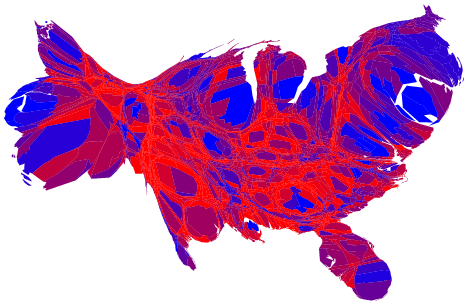
Another election map. This is not your country on drugs; it's what it really looks like. From Maps and cartograms of 2004 US presidential election results (hat tip to dave)
And this interesting factoid, from the DailyKos site: More people (56 million) voted against this president than any other in history. And this, also from Kos: Bush got the smallest percentage incumbent win since Woodrow Wilson in 1916.
My first compositional efforts using the SidStation synth, playing the notes in a notation program I downloaded called Harmony Assistant. I'm having fun, don't kid me too much.
"Funky Mountain Lake" [mp3 removed] The SidStation played "acappella," using the Lillhagen patch. I like the way the patch never seems to do the same thing twice--it always seems on the verge of breaking down or going seriously out of tune. And that it can add syncopation to a fairly clinical series of notes (see below) is amazing.
"Mountain Lake (Not Funky)" [mp3 removed] This is sort of a bonus track. It's the exact same sequence of notes used for "Funky Mountain Lake." The "lead" is the SidStation using the Autorepeat patch. I added another staff below it playing the same tune, using a kind of cheesy Harmony Assistant sound called Synthpad/Fantasia. This is unabashed Tangerine Dream/Phil Glass stuff, thrown in mainly to show how the Lillhagen patch utterly transforms the notes.
My complete musical works in .mp3 form are here.
We've been having a rousing discussion in the comments to the previous posts about the Karl Rove electorate manipulation--I mean, Bush victory. Too much of it has centered on whether the left is "too angry" and will turn off yahoos, when it's obvious that the Republicans won by channeling and redirecting mass rage. The issue to keep in mind is: Bush started a war against a nation that posed no threat to us. To fight it, he is using systematic torture and indiscriminate bombing. It is another Vietnam. 59 million people just endorsed that. The certainty that the left (and paleoconservative right) has that this is a failed enterprise has not spread to the general public. Events may soon prove Bush wrong more conclusively, but in the meantime it's important that we keep discussing, ridiculing, and even...horrors...hating the administration's foreign policy bungling. I believe the liberal left is innately better at getting out such memes because there's more creativity here, even though I wasn't that impressed with this year's political ads. Michael Moore, however, rules.
A few people asked how the Dorkbot talk went on Wednesday. I'd say well. For two hours everyone swallowed their politics (incredibly, since we were all still reeling after Kerry's concession) and had a nice talk about art. My bit ran about 30 minutes, and I enjoyed my first presentation using a laptop, projector and the Internet in lieu of the old slide projector. (Unfrozen Caveman Lecturer.) Seeing my portraits, animation, and abstraction blown up that big was exciting. I wasn't happy with my answers to a couple of questions toward the end, so I'll try again here. 1. Why the molecules? A: They're the most rudimentary, ordinarily seductive kind of thing to draw on the computer. Fill in a rectangle, fill in a circle, shade. Before I was making them on the computer I was painting them in the style of a computer. They are a dumb branded art thing like a Newman stripe or a Poons dot (or a Michael Rodriguez molecule--he also paints them), that, as Johns said about flags and targets, "frees me up to operate on other levels." Maybe it's arbitrary or obvious--I don't care, I like 'em. 2. Where are the grids of found animated gifs you sometimes post? Are they art or curation? A: Boiling my art activity down to a 25-minute speech was hard. The narrative I chose was, "how I make art objects with a crappy old program and how my production eventually began to expand to include animations of the same kind of imagery as I began blogging." I had to leave a lot out, including my burgeoning music career (!), and the weird overlap of blogging, curating, and artmaking that has been a fairly constant theme on this page.
Also of note was the guy who kept asking Claire Corey pointed questions about why she makes digital paintings for gallery consumption. Why abstract expressionism, this art of the 50s? What do you get from printing it out that you don't get onscreen? Are you selling a painting or a file? The latter two questions came after Corey had explained the pains she went to to make a unique, color adjusted print on canvas, stretching it like a conventional painting so that it had scale and sensuousness and optical complexity in real space. I'm guessing the questioner was coming from some sort of conceptualist, information wants to be free frame of reference in that he seemed genuinely startled, perhaps a bit put out, that Claire was showing and selling her work in galleries. From what I've observed over the years, she gets it coming and going: the gallery world wants there to be actual paint somewhere on that canvas to legitimize it. For some reason, a digital painting pushes lots more buttons than a digitally made and printed photo. Very fertile area to be working, IMHO.
Many thanks to Douglas Repetto for inviting us to speak and making things run so smoothly. He's an awesome moderator, and it's great to see the Dorkbot empire gradually spread around the world.
Another map, this one via thickeye:

In the comments, Cinque H continues to call for temperate language towards the Bushvoters. He's living out there among them, so maybe it's like, don't say Big Smelly Cat when you're in a cage full of lions. I understand all that about being noble and not sinking to the level of right wing hate rhetoric, but I disagree with the analogy of the Bushvoters defending themselves being like us having to defend Clinton after Waco (and other bad things that happened from '92-'99). Barbecuing 80 Americans for their religious practices was awful, but Iraq is infinitely worse--it's simply not defensible on any level except "me dumb me see Saddam on teevee he bad man." Assuming the 59 million people aren't out and out mentally handicapped, they are morally culpable for the killing in Bush's vendetta. I'm not interested in winning them over, I'd rather see them disappear through attrition and old age (see previous post re: demographics) and keep working on the ones who didn't vote, making intellectual freedom seem fun and sexy. Also, you can't reason with the wingnuts, we have one that keeps popping up on this site repeating the same tired phrases no matter how sensitive and rational people try to be.
Well, this is encouraging. This is what the electoral map would look like if only young people voted:
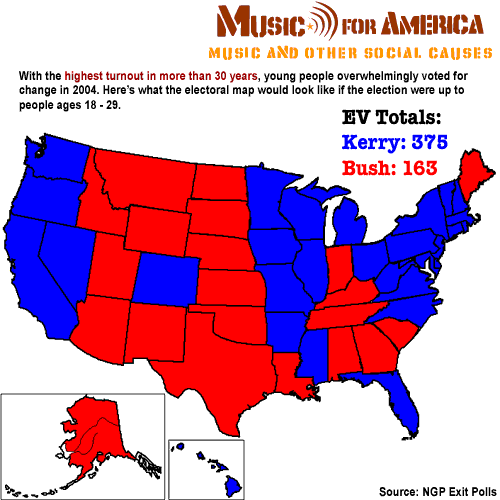
As the Daily Kos poster who found this says:
The reality is that Bush won by increasing his support in every age group above 30, adding SEVEN POINTS in the 60+ bracket alone over 2000.
Luckily for America, old people die. If we can maintain our edge with young voters and hold on to those we've got as they get older, the right wing revolution will come to an end four years from now.
The only question is whether or not we can hold the line and keep a country worth fighting for until then.
The Bush 59 Million Need a Name
Cinque H. comments on the previous post's laundry list of things Bush voters are accountable for:
These kinds of shrill blanket recriminations get us nowhere. I appreciate that the bile will be flowing for a while (I have some of my own), but the real work will be in forming alternative visions over the next 4 years, not in sitting back, spitting hate rays at people who disagree with you.If you leave out the curse words in anonymous's list, which express the anger many of us feel towards the very, um, strange 59 million that voted for Bush knowing everything we know about Bush, the list is a pretty reasonable summation of what those folks have done to us.
Alternative visions, absolutely. We do talk on this page about kicking the oil habit and bringing the troops home and taxing & regulating the have-too-muchs to help the have-too-littles. Kerry would have lost by a much wider margin if he'd clearly articulated any of those positions. Excuse some of us while we sit back stunned for a few moments, trying to get our minds around the fact that 59 million people voted proactively for Bush. It's hard to know what to say to these people going forward, in casual conversation. "So, you...like torture photos?" "Into big deficits, are you?" "I could see where you might think Bush did pretty well in the debates." It's hard to even conceive how to reach across the aisle to talk about an alternative vision right now. So let us get our hating done.
Or not. First, what are we going to call the 59 million? One of their number who I personally know said, before the election, "This is the most divided the country has been since the Civil War" before proceeding to heap insults on critics of Bush. Well, in the Civil War you had Yanks and Rebs. I never particularly liked "red states" and "blue states." The 59 million need a name. The God Squad? Bushvoters? And speaking of hating, be sure to check out Abraham Kalashnikov's fine rant, also in the comments to the previous post. I'd post it here, but I do have family members who are Christians who I love and have broken bread with even though we vehemently disagree on many issues. Don't know if they voted for Bush--they think he's a Rockefeller liberal. In deference to them I'm going to struggle (not always succeed) to keep a moderate tone on the page.
UPDATE: Good "big picture" post from Steve Gilliard frames the issue as: Bushvoters' lives are wrecked by the economy, working 50 hour weeks, etc, and were suckered into blaming their misfortunes on gay marriage. How do we make them see what their real problems are?
The following statement by anonymous sums up my feelings pretty well:
An open message to those who re-elected Bush:
You are accountable for each flag draped coffin returning home from Iraq and explaining "Why?"
You are accountable for aiding the ambition and incentive of those newly drawn to the ideology and practice of terrorism.
You are accountable for alienating our friends and allies abroad and for fostering the recent, prevalent, and probably lasting image of America as an arrogant, petulant, trigger happy nation that is the leading global arms supplier and overextended global cop with a pathetic commander in chief and a hollow culture.
You are accountable for explaining to those abroad the reasons for America's contravention and disregard for international law, rules of diplomacy, and utter hypocrisy in how it chooses to demonstrate its "commitment" to democracy abroad, moral leadership, and leadership by example.
You are accountable for many of the dollars added to our national debt.
You are accountable for what will become a Supreme Court similar to the one that brought us "separate but equal."
You are accountable for the historic disproportion and concentration in wealth and poverty.
You are accountable for a new standard in "anything goes in order to win" electoral tactics, and the unprecedented fusion of political calculus into domestic and international policy.
You are accountable for abetting state sponsored religion and eroding the founding principle of separation of church and state.
You are accountable for unfettered corporate and commercial encroachment into the civic sphere and for failure to curb corporate misbehavior and corporate goals that privatize benefits but socialize costs.
You are accountable for not better preparing the massive generation of future retirees less equipped to fend for themselves.
You are accountable for the increasing millions without healthcare.
You are accountable for the results of an unfunded mandate to "leave no child behind" and a public education system that will continue to deteriorate and produce millions more of poorly educated, disaffected, cynical youth.
You are accountable for the erosion of things that used to be considered "public goods," the use granted privilege by the state and its citizens to operate as such (public goods other than national security, of course).
You are accountable for unparalled social divisiveness insofar as much of it results from the above.
You are accountable for just being plain fucking stupid, lazy, bound to dogma, crass, and/or unable to reason beyond fears, prejudice, and susceptibility to social pressures and patent manipulation.
Obviously we are all accountable. There is an added burden on those supporting the last four years and the four years hence.
God help us all - but especially those on the islands within the island that this country wants to pretend to be.
Looks like I was right to be freaking in my previous post. I'm reading that the networks are calling this for Bush (can't stand to watch'em). The only explanations I can fathom are: The Christ-squad came out in force to defend their False Jesus;
Juan Cole has a recap on where the race actually stands as of the wee hours Wednesday morning. If offers some hope but not much.
UPDATE, Wednesday: So, I see Kerry has conceded. Ouch.
UPDATE 2: I had an epithet directed at young voters that has been deleted. According to Joshua Marshall, "Young voters showed up at a far higher level than they did four years ago. But everyone else did too. And so the proportion of the electorate made up by the youth vote did not increase. At least not dramatically..." I've heard one reason for the Bush victory was people don't want to change leaders mid-War. To some extent this is an indictment of Kerry's failure to offer an alternative. But we know he would have lost on a peace initiative. I think what it comes down to is the majority of Americans are racist and aren't offended by the idea of genocidal war.
UPDATE 3: This 1972 Hunter Thompson quote from Billmon says it better:
This may be the year when we finally come face to face with ourselves; finally just lay back and say it -- that we are really just a nation of 220 million used car salesmen with all the money we need to buy guns, and no qualms at all about killing anybody else in the world who tries to make us uncomfortable.
Steve Gilliard tells us not to sweat the election because the turnout is high, but I can't help it. Those red state numbers just turn my stomach. I'm sad to say that people I know and love support the radical right-winger over the moderate conservative. Amazing that anyone could look at those Abu Ghraib photos and say, "Yep, that's my guy!" Amazing that anyone could watch the three debates and say "Well, I think the President comported himself well, don't you?" The man was flying off the handle, drooling, smiling weirdly...is that what they want in leader? Scary times. Sorry, I'm freaking out tonight.
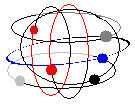 If you're in New York City, I hope you can come out tomorrow night, Wednesday, Nov. 3, for my talk at Dorkbot-NYC. Dorkbot is an informal monthly gathering devoted to theme of "people doing strange things with electricity." This month's is being held at Location One, 26 Greene Street in Soho (between Canal and Grand) from 7 to 9 pm. I've given my presentation the dramatic title "The Future of the Autonomous Art Object in a Wired World, or, How Blogging Changed My Art Life," but I'll mostly just be spieling about my artwork, while projecting some images and animated GIFs. The "virtual slides" I'll be using are posted here, minus all the illuminating chitchat. Also on the program will be Claire Corey, a digital painter I mentioned a few posts back, and Matt Hall & John Watkinson, who will be discussing their Cell Phone Drum Machine. See you there!
If you're in New York City, I hope you can come out tomorrow night, Wednesday, Nov. 3, for my talk at Dorkbot-NYC. Dorkbot is an informal monthly gathering devoted to theme of "people doing strange things with electricity." This month's is being held at Location One, 26 Greene Street in Soho (between Canal and Grand) from 7 to 9 pm. I've given my presentation the dramatic title "The Future of the Autonomous Art Object in a Wired World, or, How Blogging Changed My Art Life," but I'll mostly just be spieling about my artwork, while projecting some images and animated GIFs. The "virtual slides" I'll be using are posted here, minus all the illuminating chitchat. Also on the program will be Claire Corey, a digital painter I mentioned a few posts back, and Matt Hall & John Watkinson, who will be discussing their Cell Phone Drum Machine. See you there!One fine GREENDAY I went to school and got an F-MINUS on a test. Then in gym, we began a race on THE STARTING LINE. Then i went to the school play and THE Q was at 1208. Then i saw SOMETHING CORPERATE laying on the ground, it was a comeplete SOCIAL DISTORTION! I met a guy and he knew THE CURE for THE KILLERS and it was completely LIT by HIM. He could see into the CHRONIC FUTURE that we were having KORN for dinner.. which we were. That was his STORY OF THE YEAR. Then we went to THE USED book store and bought a BRAND NEW book. There were SUM 41 people at this store. The lady's name that worked there was LOLA RAY. And by my LOSERS LUCK, she was my NUMBER ONE FAN. Then i went home and played with the neighbor's KITTIE. THE BEAUTIFUL MISTAKE was that he bites. I walked around and told some kid to BLINK 182 times or a MODEST MOUSE will attack him with ROLLING STONES or a VELVET REVOLVER or maybe even GUNS AND ROSES. It was a MINOR THREAT. THE INTERNATIONAL NOISE CONSPERACY turned their AUTOPILOT OFF when they heard about this. The moon began to SHINEDOWN, NO DOUBT. I sat in a SILVERCHAIR in THE DARKNESS of my room. I went to bed and had a TWISTED and DISTURBED dream about the fact that IMA ROBOT and i had a SIMPLE PLAN.. it was so NSYNC .. i found the LOST PROPHETS. The next morning i ate a LIMP BIZKIT. And then i went outside and trimmed a BUSH. It was now THURSDAY and i found a YELLOWCARD. Tuns out it belonged to a SUGARCULT. It had NOFX on us though. We later went to the LINKIN PARK and decided to RISE AGAINST THE CASUALTIES but they were AGAINST ME so they had their BOYS NIGHT OUT and went BOWLING FOR SOUP. We were HIDDEN IN PLAIN VIEW in a BOX CAR RACER eating BLACK EYED PEAS, watching a MOTION CITY SOUNDTRACK. I ate a VITAMIN C and my mouth was full of SALIVA. We were STARING BACK UNDEROATH on a dark MAE night. Months past and now its THE EARLY NOVEMBER.. we found some bugs and their PAPA ROACH. Now i wish i was TAKING BACK SUNDAY because now there is a DEAD POETIC in my neighborhood.. and we had to go to A FUNERAL FOR A FRIEND.. enough said. I met this guy named BILLY TALENT and he said he wasn't mean, NOR AM I. We heard A STATIC LULABY in the background telling us that our adventure was over.. the end~!
It is election day. I plan to vote for John Kerry. According to a recent New York Times poll, 45% of the American public doesn't think George Bush Jr.'s presidency has been legitimate due to the shenanigans last time around. I consider myself part of that number. I urge everyone to get out and vote and not do vote-swapping for Nader or whatever or assume that because you're not in a swing state it's OK to stay at home. We need the strongest possible anti-Republican, anti-Christian right (and I wish I could say antiwar) mandate through the size of the popular vote, and that means getting out and voting for Kerry.
| 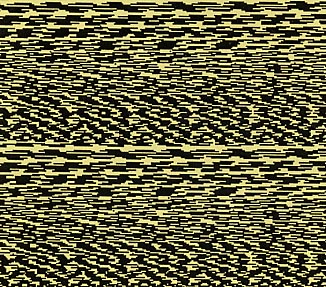 |
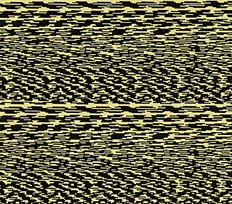 |  |
 |  |
| 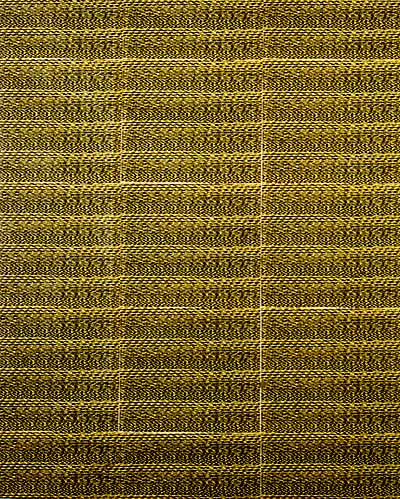 |
When I sent a drawing from the MSPaintbrush program on my computer to the network printer, the printer routinely sent back a message announcing that the job was finished. This caused a slight power surge, and I discovered that if I was sending another drawing to the printer at the exact same moment, the signals would cross and the second image would get "zapped," printing out as a uniquely garbled geometric pattern. I actually learned to time to the split-second when to send the drawing to get a good "scramble."
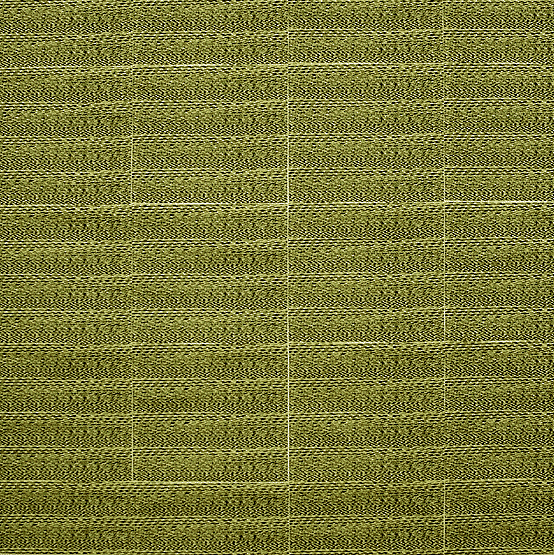
I made multiple photocopies of the scramble-pattern and joined them in a grid, applying linen tape to the back of the paper and then folding the paper around a painting stretcher and stapling it on the back. The result is a rather elegant, minimal quasi-painting born out of the drudgery of the modern office (during periods of official "down time," of course). The differences in color in these web pictures are just discrepancies among the scanner, slide, and digicam images used to make them.
I started thinking about this work again after the recent interview where jenghizkhan said "I started making music by scratching CD's [as in hiphop, turntable scratching] that I made from digital noise samples (similar to modem tones). I got the samples from saving the screwed up files that my computer sequencer would spew out when it crashed (which was all the time in the beginning). The scratching occurs sometimes at a super subtle and slow rate so that I can draw out all the tones that make up the white noise of digital streaming information."
That got me thinking about visual equivalents to those kinds of sounds, and the interest that exists across disciplinary lines in digital by-products, especially down at the "molecular level."
